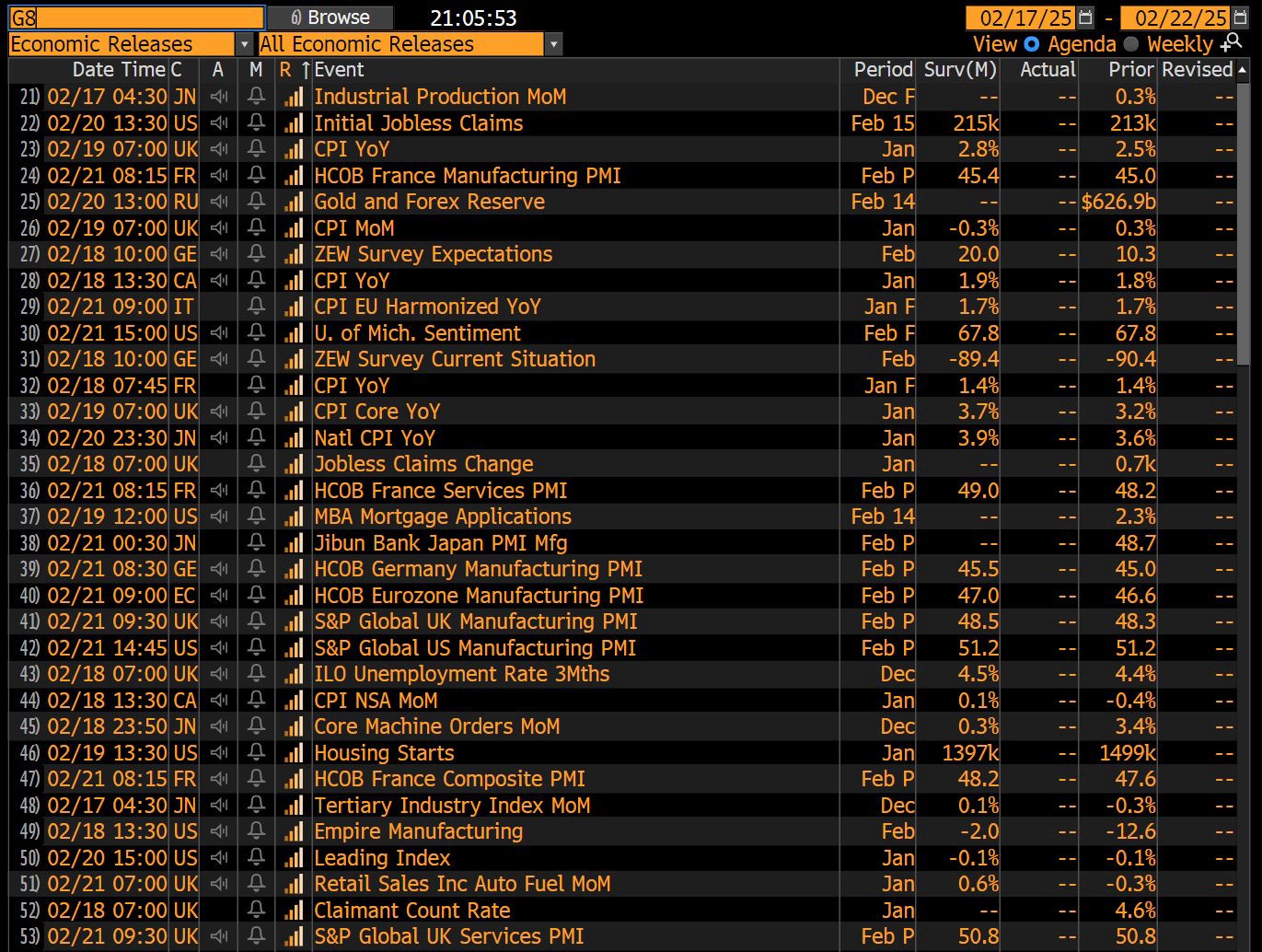Top Trade Ideas - February 17th
Stocks kicked off last week with gains, rebounding after a slide driven by concerns over inflation and US tariff threats. The dollar strengthened and gold hit a record high. However, the dollar strength was short-lived and closed lower on the week.
U.S. inflation picked up broadly at the start of the year, with the monthly consumer price index rising in January by the most since August 2023. Fed Chair Jerome Powell said the latest CPI shows that while the central bank has made substantial progress toward taming inflation, there is still more work to do, “so we want to keep policy restrictive for now.”
Over the weekend, Trump’s tariff plans have sparked threats of retaliation while Vice President JD Vance attacked longstanding European allies at a security conference. Plans to negotiate an end to the war in Ukraine have left the bloc on the sidelines.
The Week Ahead
U.S.
The minutes from the Federal Reserve’s January meeting will be released on Wednesday and are anticipated to provide insights into the likelihood of interest rates remaining stable in the near future, especially given concerns that inflation could persist at higher levels for an extended period. Investors will be particularly attentive to any comments regarding the potential inflationary effects of President Trump’s proposed policies, including trade tariffs.
In January, rates were held steady, and both the accompanying statement and Chair Jerome Powell's subsequent testimony indicated that the Fed is in no rush to lower rates.
Bank of America analysts believe that the minutes will likely show little “sharp deviation” from the Fed’s recent statements.
Moreover, recent U.S. inflation data has surpassed expectations, and job reports point to a robust labour market. Consequently, U.S. money markets are not fully adjusting for another rate cut until September, with analysts suggesting a reasonable possibility that the Fed’s next move may actually be to increase rates.
On Friday, the S&P provisional purchasing managers’ surveys for the U.S. manufacturing and services sectors will be released, offering a snapshot of economic performance, with expectations pointing to continued expansion. Additionally, the University of Michigan will release its final consumer survey for February on the same day.
Other notable data to watch includes January's housing starts on Wednesday, weekly jobless claims on Thursday, and January existing home sales also on Friday.
U.S. markets are closed Monday for a public holiday.
Eurozone
In what is expected to be a quiet week for economic data in the region, the flash estimate purchasing manager indices for France, Germany, and the eurozone will be the key highlights, especially as uncertainties surrounding U.S. President Trump's tariffs continue to linger.
This follows January's PMI, which indicated a positive start to the year, with improvements primarily driven by the manufacturing sector and an uptick in growth expectations.
On Tuesday, Germany will publish the ZEW economic sentiment index, while France will release final CPI data for January. Additionally, consumer confidence surveys across the eurozone will be made available on Thursday.
Thursday will also see the release of German producer prices for January, and on Friday, Italian CPI data is set to be published.
Also noteworthy is that Germany is gearing up for elections on February 23.
U.K.
This week, the U.K. is set to release key economic data, with jobs figures coming out on Tuesday and consumer price inflation numbers following on Wednesday.
These reports come on the heels of stronger-than-expected growth data for the fourth quarter, along with December's figures, which have slightly dialed down forecasts for future interest rate cuts by the Bank of England.
Earlier this month, the Bank of England lowered interest rates and indicated that more gradual cuts could be on the horizon. However, sluggish economic growth still leads money markets to anticipate a 19% chance of another rate cut in March.
If inflation numbers come in strong, this could dampen the chances of a rate reduction next month. Economists at Investec predict that the annual CPI will climb to 2.9%, driven by factors such as the new VAT on private school fees, along with increases in fuel prices and airfare.
Onto the trade thoughts for the week.
FX
Annoyingly, our view on EUR/USD, which we put a trade out last week, was correct, but our limit order to buy was just a bit too low to get filled.
Our conviction remains the same in terms of wanting to play the dollar from the short side, with tariff chatter becoming more bark and no bite (reciprocal tariffs hyped up ahead of Thursday but reality was something that should come into effect in April).
The reaction to CPI and PPI releases from the U.S. last week was also telling, and so it opens the door for xUSD to move higher again this week.
We look for a clean break and hold above 1.0500 to support further gains on a week that’s lighter on major data flows.
TRADE IDEA - FURTHER GAINS FOR EUR/USD
Buy an EOM expiry 1.0550 Call costing 0.35%, targeting a move to 1.0700 for a 3:1 RR




